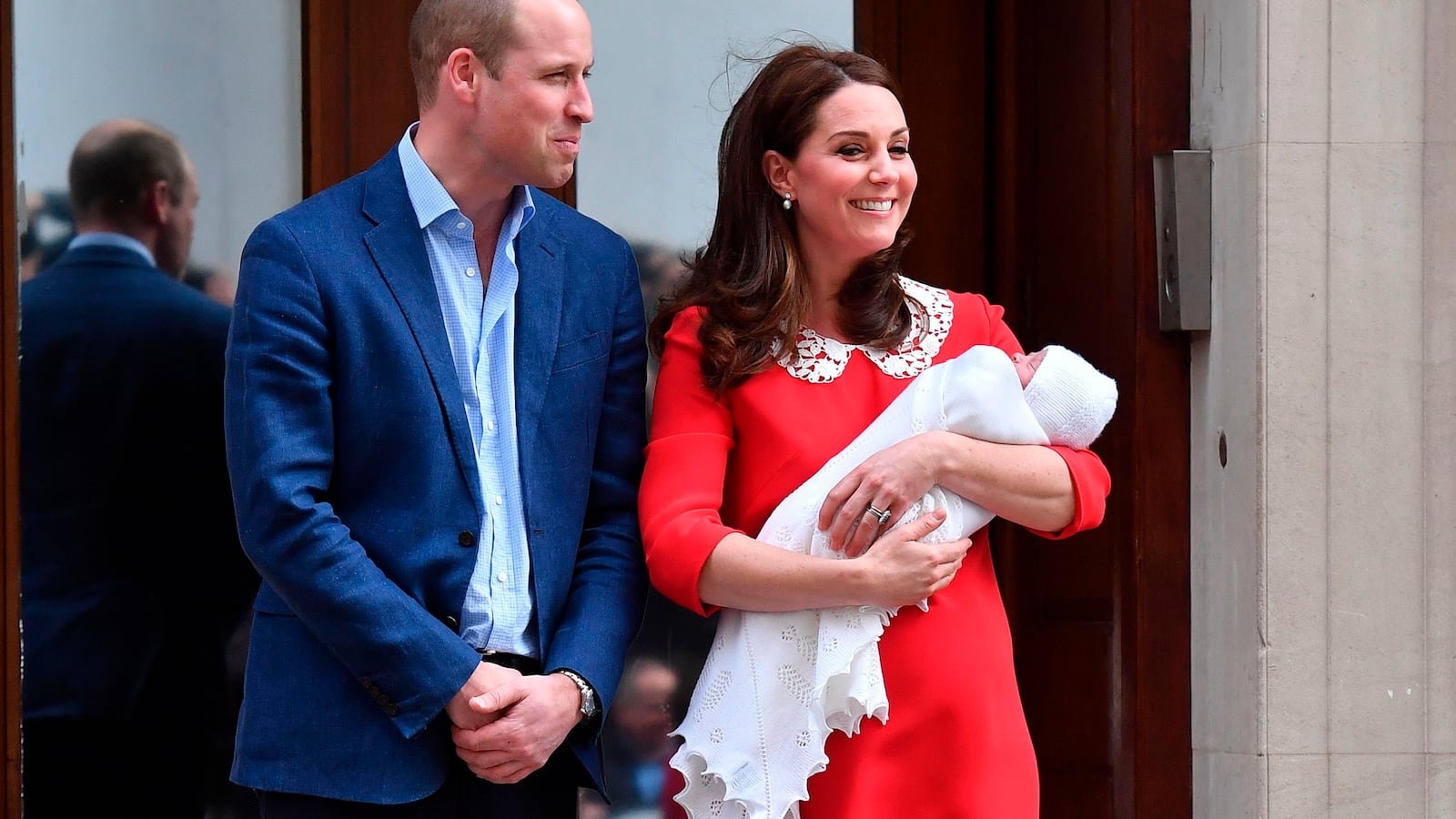On Monday evening, hours after Kate Middleton had given birth to her newborn son and posed outside the Lindo Wing of St. Mary’s Hospital in London holding him, the media were heavily in decoding mode.
As royalty is largely symbolic—and royal births are definitely at the most pronounced and weird end of symbolic public exercises, with town criers and royal devotees dressed up in the Union Jack and waiting outside the hospital in feverish anticipation—you can forgive the media race to the archives to find that Princess Diana had worn a red-colored outfit when presenting Prince Harry to the world in 1984.
On Monday, Kate Middleton wore a red dress when presenting her as-yet-unnamed third child to the world. This, then, was a tribute to Princess Diana; especially as Princess Diana wore a dress with dots when presenting Prince William to the world, and Kate wore a Jenny Packham polka dot dress when presenting Prince George to the world.
Sure, both women were standing on the steps of the Lindo Wing, but it is apparently inconceivable that Kate Middleton can wear dresses devoid of any symbolic importance.
Of course, symbols flourish to the benefit of both the royals and the media. The Cambridges likely want to say little and look as good as possible, and then—like any couple who have just had a baby—get the hell home. Yet posing outside the hospital is necessary for the royals: It’s the mission accomplished money shot. The royal line continues, and here’s the happy, dimply truth of it all. The media are the ever-faithful recorders.
Kate and William are surrounded by security and unimaginable privilege, so one’s sympathy is qualified by that—but it still must be very strange and stressful to know that as soon as you have given birth, you must be made over to look media-ready to present your child to the world.
Just as hawkishly observed as the royal couple Monday was the presence of stylists and hairdressers.
The pressure to look good enough for media consumption hours after giving birth seems particularly perverse. Just what kind of society demands fashion perfection from anyone hours after they have given birth?
The Independent has its own, now well-practiced take on the media madness of such days as Monday. Its headline was “Woman Gives Birth to Baby Boy.” It doesn’t care, you see. But then it published another six stories about the birth, so it does seem to care.
What also happened Monday was a piece of public theater that once again showed the grotesque public ownership of Kate Middleton’s body. Her size and clothes are monitored on a daily basis. And so the birth of a child, what should be a private day for most humans—and the loved ones they choose to be with—instead becomes yet another public engagement because Kate and William’s children are not just royals, they are the ones most adjacent to the throne.
The media, much as they want these children to look cute to sell newspapers, also need them as new characters in the royal soap opera. This child, we were told all day Monday, is fifth in line to the throne, displacing Prince Harry to sixth.
(The royal pregnancy saga permutations are endless, by the way. Pippa Middleton, Kate’s sister, is reportedly pregnant, and just wait for the hullabaloo around Meghan Markle and Prince Harry’s family building, if and when that is underway.)
Much has been said about Prince William and Kate Middleton’s comparative laziness when it comes to carrying out royal public engagements. Much has been said about their desire for privacy. Some of the criticisms are fair. They have all they could wish for, and they are cosseted and protected to an unimaginable degree. They are the new generation of a privileged institution; they need the public to love them in order for “the Firm” to survive.
But they and their children are also living in the strangest goldfish bowl. Kate’s body and baby are royal vessels just as so many royal wives before her, given over not just to building a family for her and her husband but to the maintenance of a historic, class-streaked institution. The royals needed Monday’s photo call as much as the media; two different purposes were served.
Kate and William’s children are theirs, and they are also not just theirs but part of a grander plan—and the country watches on as they grow, just as they did with the queen, and her children, and now her children’s children and their children.
Imagine your water breaking, and that being announced as a breaking news story. Imagine being in labor and giving birth, while knowing—beyond the effort and emotional and physical toll of that—that you are expected to be blow-dried, primped, made up, and looking media-ready hours later.
Somehow, for some reason, a royal birth becomes a model to emulate when it really shouldn’t. There are a lot of helpers keeping the royal show on the road. We should judge it—the happy smiles, the dress, the makeup, the hair, the cool and easy dad-ness of William, the lovely picture of heterosexual coupledom in full, complete bloom—as equal parts joyous and surreal spectacle, not as template.
We should be happy for Prince William and Kate Middleton. But we should also grimace at the circus a day like Monday has become, and the ultimately misogynistic meaning of what the circus is. A woman gave birth, and then her body and baby were given up to the watching world.
What do the photographs really show? A happy family, one hopes. Also: a royal wife’s body that is her own, and not simply her own. A baby that is her own, and not simply her own. And now she’d quite like to go home, thanks very much.






